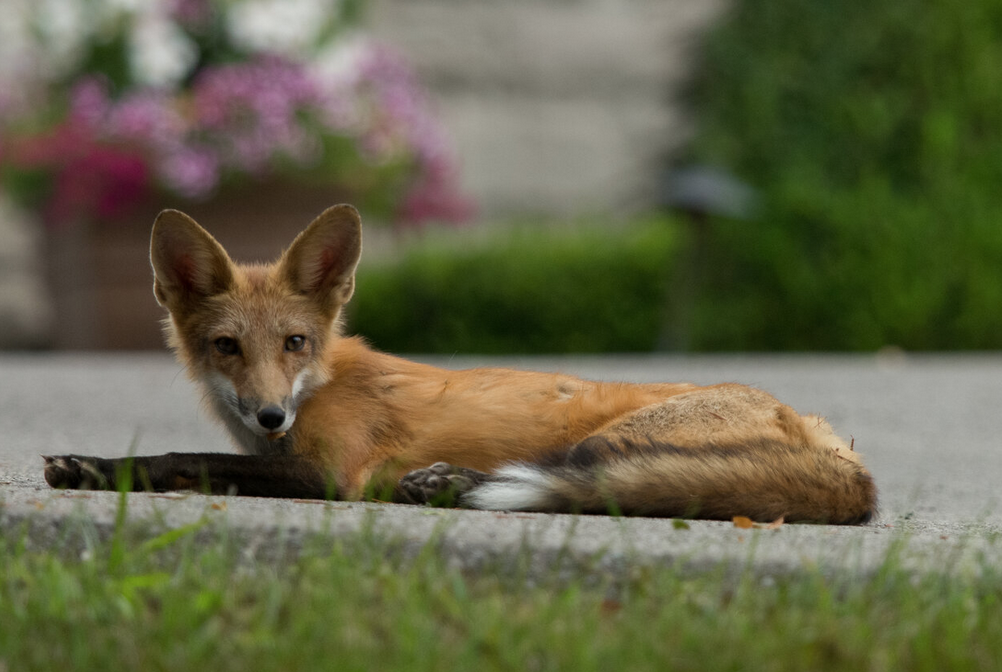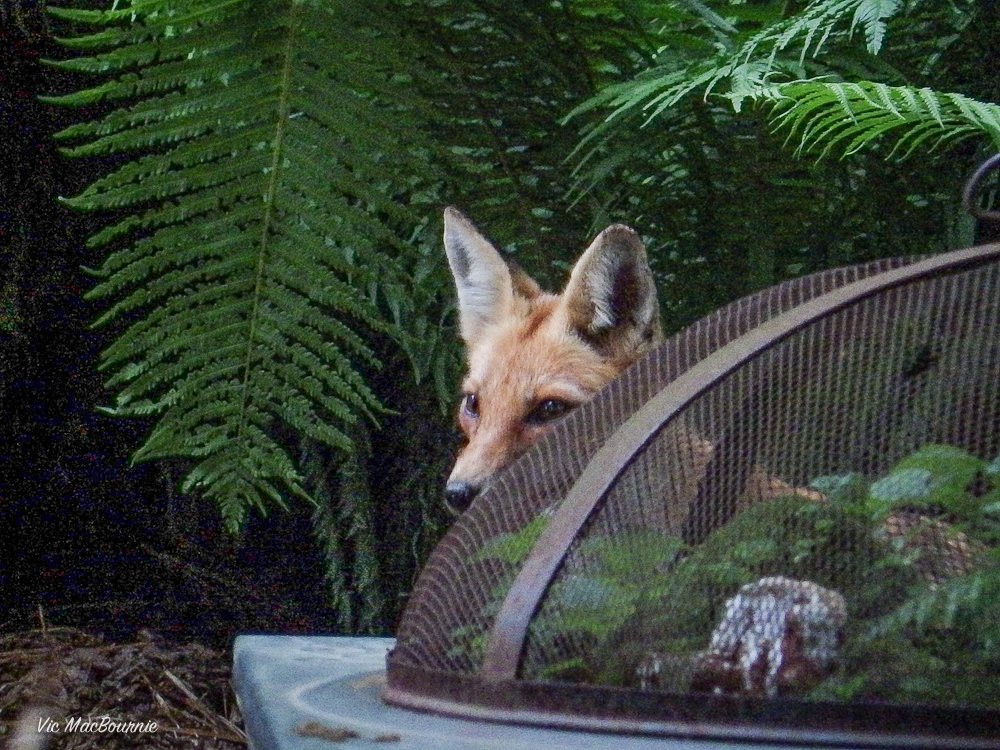Welcome the urban fox: The ultimate rodent controller
Urban foxes are common throughout North America and are important predators in the control of rodents in our woodland gardens. Here are tips to help gardeners encourage them and help them survive and prosper in our gardens.
Do fox control mice and rats?
Our first fox sighting came on Day 2 after moving to our new, old home some 22 years ago.
My daughter and I were out for a stroll in the woods surrounding our home when a fox appeared on the path right in front of us, looked at us and went on its way without a care in the world.
Not long after, a fox visited the backyard bird feeder where it scored a black squirrel pretty much on a daily basis for several weeks. Every morning at breakfast, my daughter and I would see the fox appear out of nowhere, chase down a squirrel across the yard, catch it, and with a hard shake immobilize it, before carrying it back to its den no doubt for its kits.
Needless to say our squirrel population was kept nicely in check with the Red Fox around.
While squirrel is certainly on their list of preferred food, there is no question that mice and other rodents make up a high percentage of a fox’s diets throughout the year, especially in urban areas. Studies show that urban fox feed predominantly on small mammals, particularly rodents like rats, mice and voles. Rabbits are also among their preferred food choice. Together, these can make up about 50 per cent of their diet.
Our cute little neighbourhood fox taking a rest on a driveway before an evening of hunting. July is a difficult time for fox, and it shows here in the fox’s skinny body .
Ever heard a fox scream. It’s terrifying but fascinating. For more on why foxes scream, check out my post here.
But then they pretty much disappeared for years. Foxes became rare around these parts, apparently decimated by mange.
But they’re back and I couldn’t be happier.
Not sure our local rodent population is as excited about their return as I am, however. Urban foxes help control small mammals, particularly rodents including rats, mice and voles. Squirrels and rabbits are also on the menu to a lesser degree.
This alone is reason enough for gardeners to love these little canines.
Check out my earlier articles on Why do Foxes Scream and Why Foxes steal from our gardens
We have been noticing foxes in the area again for the past two years. This winter I noticed a fox at a neighbour’s property in mid winter. It greeted my dog and I after we returned for a walk. It was in January, about the time of peak mating period. This is about the time these usually quiet little fellas become quite vocal often screaming and barking as the males roam the neighbourhood looking for partners.
When do fox begin breeding?
By February the females are pregnant and begin clearing out den sites in and around our gardens (under decks, sheds and large tree stumps).
Cubs are usually born mid-march, totally deaf, blind and in need of their mother’s constant warmth. By April the cubs emerge from their dens and start eating solid food. By May the den is an active place, especially at dawn and dusk when the parents are busy bringing the growing kits food.
This photo shows on of our neighbourhood foxes killing its prey after pouncing on it in the garden. It’s not a pretty site to watch but our gardens can be good sources of food for neighbourhood foxes.
What do foxes eat?
Foxes are actually extremely opportunistic, omnivorous predators. Besides rodents, Fox will happily feed on invertebrates, particularly various beetles, butterflies and moths as well as earthworms, grasshoppers and crickets. And those pesky garden snails and slugs are also on their menus. Spiders too, are on their list of good eats.
To a lesser degree, Fox will eat frogs and small snakes.
Birds also make up a large part of a fox’s diet, especially in the spring and early summer when foxes are feeding their hungry cubs.
Some foxes have even been known to climb trees in search of prey or fruits and nuts.
Fox kits hanging out a their roadside den.
In an urban garden, there is no doubt that bird feeders provide the perfect opportunity for a fox to easily satisfy most if its nutritional needs. Everything from rats and mice to squirrels, chipmunks and a host of birds gather around the feeder, often letting their guard down just enough to become dinner for the fox.
Being the ultimate opportunist, Fox will feed on whatever is abundant in your area. Whether that’s bugs or rats, the fox will play an important role in keeping populations in check.
Do fox eat worms?
A 1980 study showed that worms played a major role in a cub’s diet during August and September as the cubs, born in March, begin using their own hunting skills to catch worms. The study found that during some months, earthworms may account for more than 60 per cent of a fox’s calorific intake. The study estimated that it would take approximately 120 worms in a night to meet a fox’s caloric needs.
Do fox eat larger animals than mice and rats?
In other areas, hedgehogs, deer, otter, European badger, opossum, raccoon, porcupine, and even wild boar are on the menu. Fox remains have also turned up in their diets as have domestic cat, but many of these animals are expected to be the result of scavenging.
Do fox eat plants and berries?
It’s not all about meat, however. Fox will happily eat a range of plant material, especially fruits, both wild and cultivated. ( I have noticed that my blueberries are disappearing just as they begin to ripen.) Blackberries, raspberries, cherries, apples plums, grapes and even nuts are important foods for the fox as winter approaches. Studies show that fruit accounts for about 10 to 30 per cent of the diet.
And not unlike our domestic canines, grasses, sedges and various tubers find their way into the diet of most foxes.
For a more detailed look at the fox diet, go to Wildlife Online.
The main picture that accompanies this blog was taken at the end of July and it shows. At this time adult fox are often showing the strains of three months of having to provide for their growing cubs. It’s during this time that the fox begin to slow the feeding of their cubs and actually start competing for food with them. This is a dangerous time for the young foxes that are often forced to go out on their own to explore and fend for themselves.
If they survive, they begin to put on their winter coats in September and October in preparation for a long, hard winter. Male cubs leave the den area in late fall, early winter to look for their own territories.
And it all begins again.
How can the Woodland gardener help foxes?
It’s clear that providing a natural area, free of insecticides, that provides a combination of food sources including small rodents, fruit and nuts, while also providing water sources and potential den sites, is a goal all woodland gardeners should strive for. The brush pile we talked about in an earlier post becomes a hunting ground and a potential denning site for fox.
On-ground water bowls become a life-saving source of fresh water during a heat spell. Our humus-rich soil provides homes to insects and a source for earthworms. Leaving debris around the garden like branches and leaves give rodents like mice a place to live and, in return, a source of food for predators such as fox, owls and even snakes.
And, if our properties can only provide a few of these resources, we can provide a green island in a neighbourhood of green islands where a predator like the fox can exist.
We can be the ark (Acts of Restorative Kindness) that Irish landscape designer Mary Reynolds urges in her book The Garden Awakening and on her website, even if our gardens are small islands in a sea of islands.





